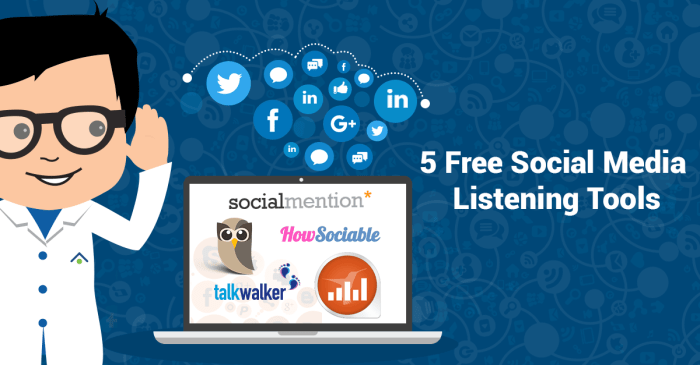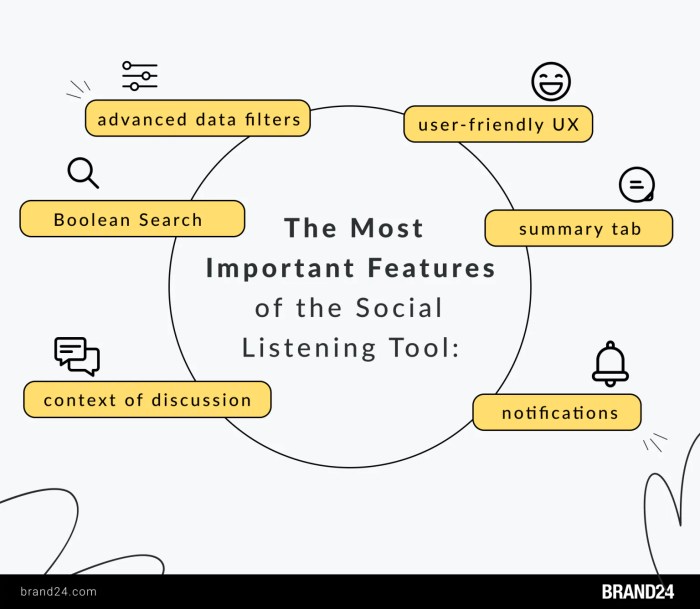Using Social Listening Tools sets the stage for this enthralling narrative, offering readers a glimpse into a story that is rich in detail with american high school hip style and brimming with originality from the outset.
Social listening tools have revolutionized the way businesses interact with their customers online, providing valuable insights and data to drive decision-making. In this guide, we will explore the world of social listening tools and how they can elevate your business to the next level.
Understanding Social Listening Tools: Using Social Listening Tools

Social listening tools are platforms that allow businesses to monitor, track, and analyze conversations and mentions about their brand, products, or industry across various social media channels. These tools help businesses gain valuable insights into customer sentiment, trends, and preferences, which can be used to inform marketing strategies, improve customer service, and enhance brand reputation.
Examples of Popular Social Listening Tools
- Sprout Social: Offers monitoring, analytics, and reporting features for social media management.
- Hootsuite: Allows users to schedule posts, engage with followers, and track social media performance.
- Brandwatch: Provides real-time monitoring and analysis of social media conversations and trends.
- Buffer: Helps businesses manage their social media accounts, schedule posts, and analyze performance metrics.
Importance of Using Social Listening Tools for Businesses
Social listening tools play a crucial role in helping businesses stay informed about what customers are saying online. By monitoring social media conversations, businesses can identify trends, track brand sentiment, and address customer concerns in real-time. This information can be used to improve products and services, tailor marketing campaigns, and build stronger relationships with customers.
Benefits of Using Social Listening Tools

Using social listening tools can provide businesses with a plethora of advantages that can help them stay ahead of the competition and better understand their target audience. Let’s explore some key benefits of utilizing these tools.
Understanding Customer Sentiment
Social listening tools allow businesses to monitor what customers are saying about their brand, products, or services in real-time across various social media platforms. By analyzing this data, companies can gain valuable insights into customer sentiment, identify trends, and address any potential issues before they escalate. This helps in improving customer satisfaction and loyalty.
Aiding in Competitor Analysis
In addition to understanding customer sentiment, social listening tools can also be used to track and analyze competitor activities and sentiments. By monitoring conversations about competitors, businesses can identify gaps in the market, benchmark their own performance, and capitalize on opportunities to differentiate themselves. This competitive intelligence can inform strategic decisions and help businesses stay one step ahead in the market.
Features to Look for in Social Listening Tools
When choosing a social listening tool, it is crucial to consider a variety of features that will help you effectively monitor and analyze online conversations. These features can vary from platform to platform, so it’s important to understand the key elements to look out for when making your decision.
1. Sentiment Analysis
- Ability to analyze and categorize online mentions as positive, negative, or neutral.
- Helps in understanding the overall sentiment towards your brand or products.
- Enables you to identify trends and patterns in customer feedback.
2. Data Visualization
- Graphs, charts, and dashboards that provide a visual representation of data.
- Helps in quickly identifying key insights and trends.
- Allows for easier communication of findings to stakeholders.
3. Monitoring
- Ability to track specific s or phrases relevant to your brand or industry.
- Allows you to stay informed about what people are saying about specific topics.
- Helps in identifying emerging trends and topics of interest.
4. Influencer Identification
- Capability to identify and track influential individuals in your industry or target audience.
- Helps in building relationships with key influencers for marketing purposes.
- Allows you to leverage influencer partnerships for brand promotion.
5. Real-Time Monitoring
- Instantaneous tracking of online conversations as they happen.
- Enables you to respond quickly to any issues or crises that may arise.
- Provides up-to-the-minute insights for timely decision-making.
Best Practices for Implementing Social Listening Tools
Implementing social listening tools effectively is crucial for gaining valuable insights and staying ahead of trends in the digital landscape. Here is a step-by-step guide on how to make the most out of these tools:
Setting Up Alerts and Notifications, Using Social Listening Tools
- Identify key s and phrases relevant to your brand or industry.
- Choose the social media platforms you want to monitor.
- Set up alerts for mentions, hashtags, and specific topics of interest.
- Customize notification settings to receive real-time updates.
Analyzing and Acting Upon Data
- Organize the data gathered into categories like sentiment, trends, and customer feedback.
- Identify patterns and insights to understand audience preferences and behaviors.
- Create an action plan based on the findings to improve customer engagement and brand reputation.
- Track the outcomes of your actions and adjust strategies accordingly.






